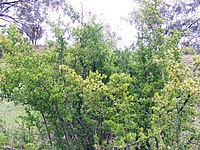
Photo from wikipedia
Lycium ruthenicum Murry. is a highly nutritional cash crop due to its fruit abundant anthocyanins. To understand the complex metabolic networks underlying the color formation in black and white fruits… Click to show full abstract
Lycium ruthenicum Murry. is a highly nutritional cash crop due to its fruit abundant anthocyanins. To understand the complex metabolic networks underlying the color formation in black and white fruits of L. ruthenicum, we conducted transcriptome and flavonoid metabolic profiling to identify the candidate genes possibly involved in flavonoid biosynthesis. As a result, 147 flavonoids were identified and there was almost no anthocyanin in white fruits, while luteolin, kaempferol, and quercetin derivatives showed markedly higher abundance. Furthermore, applying weighted gene co-expression network analyses, 3 MYB, 2 bHLH, 1WRKY and 1 NAC transcription factor, associated with anthocyanin biosynthesis were identified. A bHLH transcription factor, LrAN1b showed the greatest correlations with anthocyanin accumulation with no expression in white fruits. In addition, gene function analysis and qRT-PCR experiments identified a new activated anthocyanin MYB transcription factor designed as LrAN2-like. Yeast two-hybrid and transient tobacco overexpression experiments showed that LrAN1b could interact with LrAN2-like and LrAN11 to form MBW complex to activate the anthocyanin pathway. The yeast one-hybrid experiment indicated that LrAN2-like bonded anthocyanin structural gene LrDFR and LrANS promoters. Heterologous expression of LrAN1b in tobacco can significantly increase the anthocyanin content of tobacco florals and capsules, and activate anthocyanin synthesis related genes. Taken together, an anthocyanin regulatory network model in L. ruthenicum fruit was proposed firstly and we speculate that the white fruit phenotype was due to abnormal expression of LrAN1b. The findings provide new insight into the underlying mechanism of flavonoids, laying the foundation for future functional and molecular biological research in L. ruthenicum.
Journal Title: Frontiers in Plant Science
Year Published: 2020
Link to full text (if available)
Share on Social Media: Sign Up to like & get
recommendations!